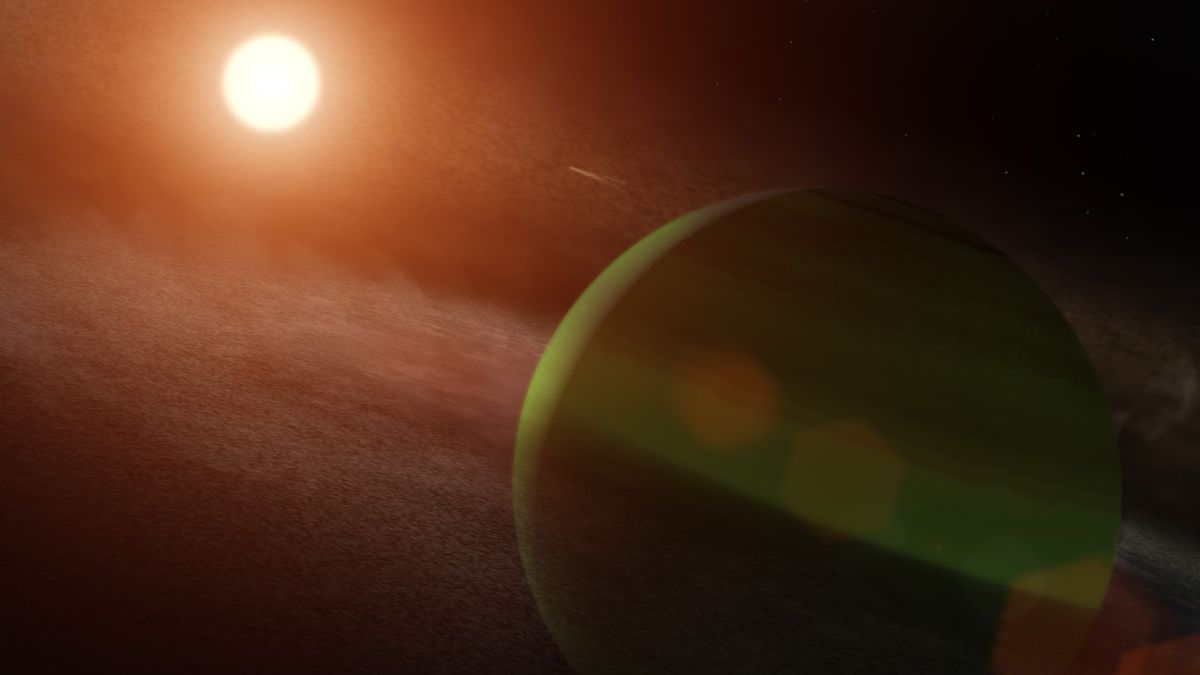
Two veteran NASA planet-hunting missions found a Neptune-size planet that circles its young star every Earth week. But don't expect habitability here: The star throws epic temper tantrum-like storms.
The newly found planet — called AU Microscopii b or AU Mic b for short — was discovered by plumbing data gathered by the agency's Transiting Exoplanet Survey Satellite (TESS), as well as the recently retired NASA Spitzer Space Telescope. Researchers hope to learn more from AU Mic b about how planets evolve, including how their atmospheres form and interact with their parent stars.
The star (AU Mic) is a young, 20-million to 30-million year-old M dwarf star known for sending out epic and highly irradiated flares into its neighborhood. (By contrast, Earth's sun is larger, prone to smaller and less dangerous flares, and older, at 4.5 billion years old.)
Related: Another day, another exoplanet, and scientists just can't keep up
M dwarf stars are favored hunting grounds for planets because the stars' diminutive size makes it easier to spot planets passing across their surface. Planetary gravitational tugs on M dwarfs are also easier to spot, which can teach scientists more about a newly spotted world.
While AU Mic b is not expected to be a habitable world, given its size and the active star nearby, astronomers have already found several key metrics in the system to better understand planetary formation in general, co-author Bryson Cale, a doctoral student at Virginia's George Mason University, said in a NASA statement.
"It's surrounded by a vast debris disk in which moving clumps of dust have been tracked, and now, thanks to TESS and Spitzer, [we know] it has a planet with a direct size measurement," Cale said. "There is no other known system that checks all of these important boxes."
AU Mic is a fascinating object to study on its own. The star is still hot and youthful, mostly shining from heat it generates as gravity pulls the star inward and compresses it. Whereas Earth's sun and other mature and stable stars fuse hydrogen into helium to create energy, AU Mic, which is still shrinking, produces less than 10% of its energy from fusion.
The star and its Neptune-size planet are nearly 32 light-years away from Earth, making them relatively close to our planet. The system is part of a young star group called the Beta Pictoris Moving Group for a particularly famous neighbor. But Beta Pictoris and AU Mic have markedly different planets, despite being neighbors.
AU Mic b whips around its star every 8.5 Earth days and is about 58 times Earth's mass. Beta Pictoris' two planets, by contrast, take 21 and 3.3 years respectively to orbit their parent star. The Beta Pictoris planets have at least 50 times more mass each than AU Mic b.
The research team suggests these planetary systems had very different formation histories.
"We think AU Mic b formed far from the star and migrated inward to its current orbit, something that can happen as planets interact gravitationally with a gas disk or with other planets," co-author Thomas Barclay, an associate project scientist for TESS at NASA's Goddard Space Flight Center in Maryland, said in the same statement.
"By contrast, Beta Pictoris b's orbit doesn't appear to have migrated much at all," added Barclay, who is also an associate research scientist at the University of Maryland, Baltimore County. The differences between these similarly aged systems can tell us a lot about how planets form and migrate."
Finding AU Mic b was difficult given how active the star is, and because is covered in sunspots — dark, flare-producing regions on the star that can masquerade as planets. The team had to carefully remove flare effects from TESS data after the spacecraft observed AU Mic in July and August 2018.
During that time, TESS caught a potential planet transiting across AU Mic, but it needed at least another observed transit to confirm the signal was real. The observing team won time on NASA's Spitzer Space Telescope to follow up on their find.
Spitzer confirmed two more transits in 2019, making the planetary discovery official. TESS and Spitzer observations also narrowed down the planet's size after the discovery team analyzed the amount of light blocked by the planetary transit, as well as the distance to the star. Calculations showed the planet is about 8% larger than Neptune.
The mass of the planet was obtained by observing how it tugs on its planet star, a technique called radial velocity, with observations performed by the W. M. Keck Observatory in Hawaii, NASA's Infrared Telescope Facility in Hawaii and the European Southern Observatory in Chile.
Scientist suspect there are more planets waiting for discovery at AU Mic. TESS and other observatories may soon take another look at the system to see what might be there.
"There is an additional candidate transit event seen in the TESS data, and TESS will hopefully revisit AU Mic later this year," lead author Peter Plavchan, an assistant professor of physics and astronomy at George Mason University, said in the same statement.
"We are continuing to monitor the star," Plavchan said, "so stay tuned."
Follow Elizabeth Howell on Twitter @howellspace. Follow us on Twitter @Spacedotcom and on Facebook.
Read Again https://www.space.com/tess-spots-fast-planet-around-small-star-au-mic-b.htmlBagikan Berita Ini















0 Response to "Newly discovered alien planet spotted zipping around highly active star - Space.com"
Post a Comment